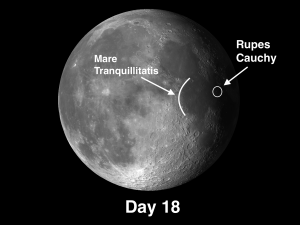The week of September 19th – 25th takes us from Lunar Day 18 through Day 24. On Monday the Moon will rise around 9:15 PM (depending on how far away you are from the center of your time zone). This week we will highlight Rupes Cauchy, visible on Monday.

Rupes Cauchy: [NE/J13] (Rupes is the Latin term for scarp: a long cliff or steep slope that results from faulting.) Two of the best-known faults on the Moon are Rupes Cauchy and Rupes Recta (the Straight Wall [SW/M9] visible on Friday — Don’t miss it!). They are fascinating to explore and they share remarkably similar neighborhoods: Both features are paralleled by a nearby rille, and in each case an intervening small crater separates the rille and the fault.
Seven miles northeast of Cauchy crater you will find Rima Cauchy, a rille that is 130 miles long, 2½ miles wide, and twists itself into a tight double “U-turn” halfway between Cauchy crater and the rille’s northwest end.
 To the southwest of Cauchy is the 75-mile Rupes Cauchy, an impressive fault that actually changes into a rille at both ends. The changeover point occurs coincidentally at two small craters that mark where the fault line starts to curve slightly to the southwest. Look carefully and see if you can detect the difference between a rima (a long groove) and a rupes (a cliff). This will be more obvious at lunar sunrise (around Day 4) as the Moon’s surface is higher on the northeast side of the fault and a conspicuous shadow will be cast toward the west, so if you’re not successful, come back on Day 4.
To the southwest of Cauchy is the 75-mile Rupes Cauchy, an impressive fault that actually changes into a rille at both ends. The changeover point occurs coincidentally at two small craters that mark where the fault line starts to curve slightly to the southwest. Look carefully and see if you can detect the difference between a rima (a long groove) and a rupes (a cliff). This will be more obvious at lunar sunrise (around Day 4) as the Moon’s surface is higher on the northeast side of the fault and a conspicuous shadow will be cast toward the west, so if you’re not successful, come back on Day 4.
On Day 18 the setting sun brightly illuminates the westward-facing slope of the fault. Because these two features are radial to the Serenitatis Basin they are probably associated with stresses that resulted from the Serenity impact nearly 3.9 billion years ago.
OF ADDITIONAL INTEREST THE WEEK OF SEPTEMBER 19-25:
The autumnal equinox is at 10:21 AM EDT on Thursday and marks the beginning of fall. This is when the Sun crosses the celestial equator on its way south and the length of day and night, contrary to popular opinion, are only approximately equal, not exactly equal. Although equinox literally means “equal night,” suggesting that the day and night are equally 12 hours long, this is not the case for two reasons: Sunrise is defined as the moment the upper edge (not the center) of the Sun becomes visible above the horizon. Similarly, sunset is the moment when the upper edge disappears below the horizon. So the time it takes for the Sun to fully rise and set is added to the length of the day and subtracted from the night. As a result, the length of day at the equinox lasts a little longer than 12 hours.
The second reason is that the Earth’s atmosphere refracts (i.e., it bends) sunlight. This refraction results in an illusion: When we think we see a fully disclosed Sun sitting on the horizon at sunrise or sunset, it is actually completely below the horizon! It’s like there was a huge mirror on the horizon showing you the Sun that was still below the horizon. This causes every day on Earth to be about six minutes longer than it would have been without this refraction. So the true date when there are equal hours and minutes of sun above and below the horizon (called the equilux — “equal light”) occurs on Sept. 25th in my hometown of Boulder, Colorado (this could vary somewhat depending on your location). Or at least this is as close as we can get it as there are five more seconds of sunlight on that day.
======================
It is highly recommended that you get a copy of Sky and Telescope’s Field Map of the Moon, the very finest Moon map available for use at the telescope. It is available for $10.95 at www.skyandtelescope.com and on Amazon. All features mentioned in this blog will be keyed to the grid on the Field Map and will look like this: Plato: [NW/D9]
Credits:
Courtesy of Gray Photography of Corpus Christi, Texas
Lunar photos: NASA / USGS / BMDO / LROC / ASU / DLR / LOLA / Moon Globe. Used by permission
- Rupes Cauchy: A Best Known Fault on the Moon - July 22, 2024
- Moon Crater Schickard – Crater Floor has Stripes - July 15, 2024
- Moon Craters Langrenus and Vandelinus - July 8, 2024